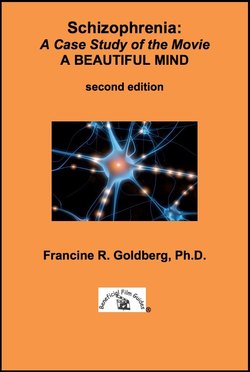Читать книгу Schizophrenia: A Case Study of the Movie A BEAUTIFUL MIND - Second Edition - Francine R Goldberg PhD - Страница 3
На сайте Литреса книга снята с продажи.
Outline of Scenes
ОглавлениеMathematics
•Introduction to John Nash
•Introduction to Martin Hansen
•Reasons for delays in diagnosis and treatment
•Unique ability to see patterns
•Introduction to schizophrenia
Age of onset
Positive symptoms
Negative symptoms
Hallucinations
Delusions
A Challenge
•Functional Impairment
Social
Academic
•The prodrome period
The Need to Focus
•Manifestation of symptoms
Hallucinations
Impoverished fluency and productivity of thought and speech
Severely impaired social interactions
Inability to focus
Diminished impulse control
Prodromol symptoms
Governing Dynamics
•Absence of symptoms
Flat affect
The Pentagon
•Reemergence of positive symptoms
Ideas of reference
Cognitive impairment in executive functioning
Teacher and Student
•Connecting symptoms to impairment
Code Breaker
•Emotional stress and pain
•Intensification of positive symptoms
Delusions of grandeur
Visual hallucinations
Tactile hallucinations
Alicia
•Full blown manifestation of positive and negative symptoms
The Prodigal Roommate
•More interpersonal stress – more intensified positive symptoms
•Overelaborate speech
The Wedding
•Residual phase of illness
•Mental status (examination)
Trouble
•Full blown psychosis
•Delusions of persecution
Dr. Rosen
•Psychiatric intervention
Mental Illness
•DSM-IV-TR
Diagnostic criteria for schizophrenia
Diagnostic criteria for paranoid schizophrenia
Multiaxial system for categorizing mental disorders
Devastation of illness
To John
To Alicia
Treatment
•Electroconvulsive therapy (ECT)
•First psychotic episode: A critical period
•Low stress environment
•Multimodal treatment
•Multi-element programs
•First generation antipsychotic medications and side effects
•Medication noncompliance and long-acting injectable antipsychotic medication
•Second generation antipsychotic medications
•CATIE comparison of first and second-generation medication
•Current research targeting the Glutamate theory
•Alerts for neuroleptic malignant syndrome and agranulocytosis
•Psychiatric Rehabilitation and Family Intervention
Psycho-education
Behavioral problem-solving
Family support
Crisis management
Delusions
•Treatment of positive symptoms vs. impaired life functioning
•Medication compliance vs. noncompliance
•Reasons for inconsistencies with treatment
•Interventions for continuity of care
•Symptom driven impulsive (dangerous) behavior
•Command hallucinations
•Risk for suicide / homicide
•Cognitive remediation and scaffolding
•Disability management
Princeton
•Psychiatric rehabilitation
•Rehabilitation readiness determination
•Skill development
•Smoking prevalence, cessation and health risk to people with schizophrenia
•Physical Illness and schizophrenia
Goodbye, Old Friends
•Cognitive remediation and errorless learning
A Nobel Prize
•More disability management techniques
•Recovery from schizophrenia is not unique
